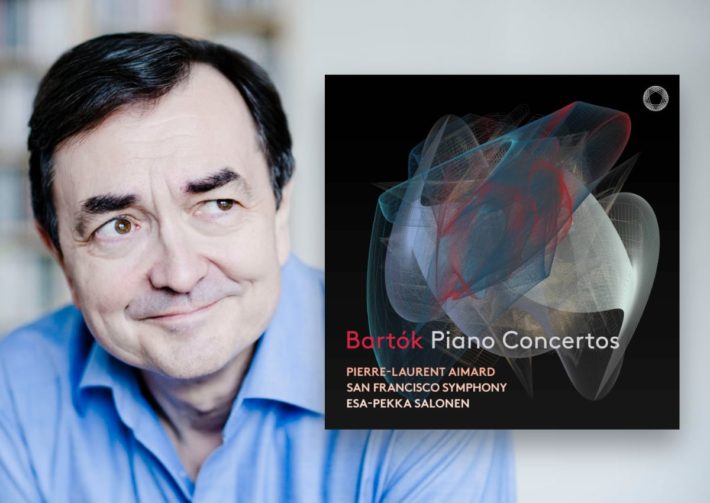Bartok’s piano concertos have never attained the same mainstream popularity as other works from the early to mid twentieth century. I suspect this is, in large part, due to the first concerto, which is exceedingly difficult not only for the soloist, but the orchestra as well. In an infamous review of its New York 1928 premiere, critic Henrietta Strauss described it as “…broken bits of themes hammered out on the piano and answered by equally angry blasts of wind instruments. The only sustained motive is that of bitterness, and the sum total is unmitigated ugliness.”
The first concerto is indeed highly dissonant, and its thematic material, rooted in Hungarian folk song, is sparse and fragmented. The second concerto is just as difficult, yet far more approachable, while the third, written for his wife Ditta as music she could perform after his death to earn income, employs less dissonant language and more lyrical writing. The continuous compositional adaptation between each concerto is particularly clear in these new, thoughtfully conceived and deeply impressive performances.
While Aimard’s technical prowess is a given, I have found him to sometimes be emotionally reticent in some of his earlier recordings. On my first listening I thought the same of these new readings, but on repeated listening I was quickly won over by his approach, which eschews the more extroverted virtuosity of Zoltán Kocsis (Budapest Festival Orchestra/Iván Fischer) and Yefim Bronfman (Los Angeles Philharmonic Orchestra/Esa-Pekka Salonen) for something more considered, that nevertheless plumbs the music’s emotional depth more fully.
In the second concerto’s middle movement, Aimard’s initial entrance (track 4, 1’41”) has a tender fragility, as if the composer is sitting as his piano quietly musing to himself, and as the timpani suggests an inner anxiety. As the music grows in volume and complexity, there is a tangible frustration and pain, answered (beginning at 5’51”) by the nightmarish hallucinations of the Presto. With Kocsis, Bronfman, and Donohoe (City of Birmingham Symphony Orchestra/Simon Rattle) I am made aware of the brilliant playing, but with Aimard (and the atmospheric playing of San Francisco under Salonen) emotions are the primary focus. The same holds true of the third concerto’s slow movement, the only time Bartok, an avowed atheist, chooses ‘religioso’ as a descriptor. Indeed, the homophonic string writing might well be described as a gentle, melancholic hymn, the orchestra’s sweetly forlorn strings and Aimard’s subtle phrasing underlining the music’s delicate beauty.
Related Classical Music Reviews
- Review: Bartók – Concerto for Orchestra – Canellakis
- Review: Bartók – The Wooden Prince & Dance Suite – Măcelaru
- Review: Rachmaninoff – The Piano Concertos & Paganini Rhapsody – Yuja Wang, Gustavo Dudamel
- Review: Beethoven – The 5 Piano Concertos – Garrick Ohlsson
These two examples are not meant to suggest these readings are only successful in slow passages. The first concerto’s opening movement has plenty of drive and the dissonance is never shied away from – but Aimard (and orchestra) find a great deal of light and shade in the writing, and even in the loudest passages he never ‘hammers’ out the ‘broken bits of theme.’ In fact, he and Salonen make the movement hang together in a completely organic way. In the second concerto, Aimard makes its exceptionally difficult music (which András Schiff once described as “a finger-breaking piece”) sound deceptively easy.
He is aided and abetted every step of the way by the San Francisco Orchestra and its new(ish) music director. Under Tilson Thomas the orchestra reached new levels of excellence, which collectors everywhere could hear in many audiophile recordings released by its in-house label. Salonen took over in 2020, but the Covid pandemic has prevented us from hearing this new partnership until now. Salonen approaches these works as unapologetically modernist, and he has inspired the orchestra shed the richly upholstered colors they developed under MTT for a less weighty, more severe color palette that ensures laser-like clarity even in the densest contrapuntal passages; The middle sections of concertos 1 and 2’s slow movements are particularly telling, and listen to the wind’s precision and leanness in the first concerto’s opening movement, which gives the music a mechanical brilliance. Pentatone’s engineers ensure the bass drum has plenty of impact. When Salonen conducted these concertos for Bronfman in Los Angeles, the Sony engineering highlighted that orchestra’s cinematic sound. Here we have a quite different sound palette that embraces a greater variety of hues in a true concert hall acoustic.
Asked a month ago, I would have argued that the 2010 recording by Jean-Efflam Bavouzet (BBC Philharmonic/Gianandrea Noseda) was one of the best recordings available, and certainly the best featuring a French pianist. But I find Aimard’s way with these works even more impressive and the San Francisco players are more characterful than their English colleagues – strongly recommended.

Bartók – Piano Concertos
Pierre-Laurent Aimard – Piano
San Francisco Symphony
Esa-Pekka Salonen – Conductor
Pentatone, CD PTC5187029
Recommended Comparisons
Donohoe & Rattle | Schiff & Fischer | Bronfman & Salonen | Bavouzet & Noseda
Read more classical music reviews or visit The Classic Review Amazon store
Follow Us and Comment:
Get our periodic classical music newsletter with our recent reviews, news and beginners guides.
We respect your privacy.









